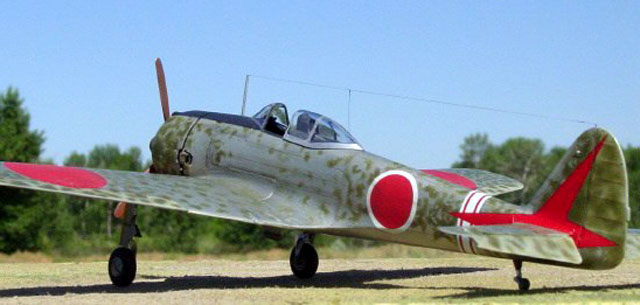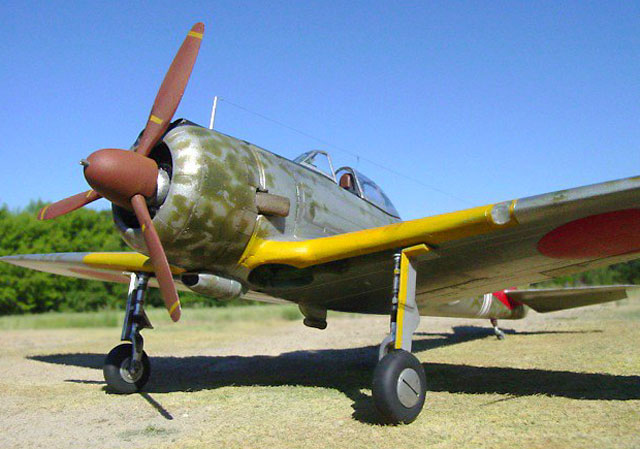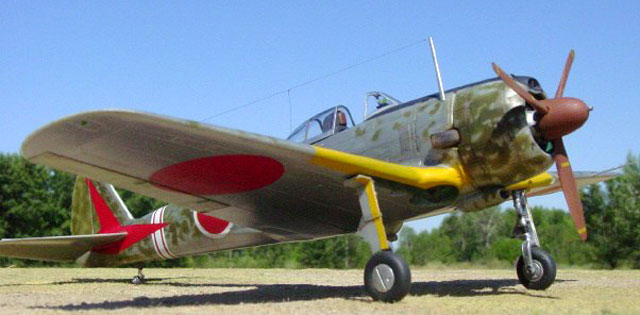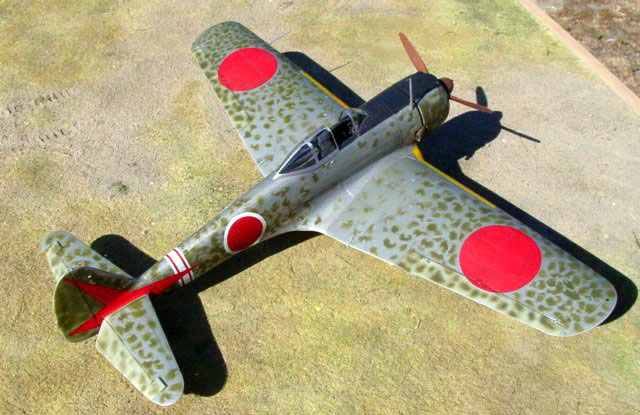|
Nakajima Ki 43-II Hayabusa (Oscar)
by
Ian
Robertson
 |
|
Nakajima Ki 43-II Hayabusa (Oscar) |

Hasegawa's 1/48 scale Ki 43II Late Oscar
is available online from Squadron.com
Although quality kits of the Ki.43 Oscar have been available in 1/48 scale
from Nichimo and Fine Molds for years, the recent releases of several versions
of the Oscar by Hasegawa represent a leap forward in design sophistication and
quality (but at an intermediate price). I decided to tackle Hasegawa's Ki.43-II
in a natural metal finish with green mottling.
|
Hasegawa's 1/48 Ki
43II Oscar |
Hasegawa's Oscars are what we have come to expect from the manufacturer -
clean and crisp parts, good fit, and excellent detail throughout, including in
the cockpit (although the opening of the cockpit is so small most of the detail
vanishes in the finished product). The kit does have a couple of minor
shortcomings in my opinion, but none that should cause more than minor
aggravation to most modelers.
The first shortcoming is that the wingtips are included as separate pieces that
bisect the ailerons. To be fair, separate wingtips are required for the various
versions of the Ki.43; however, it is unclear to me why Hasegawa cut the pieces
awkwardly across the ailerons. Nevertheless, with some putty and sanding the
wingtips can be matched well with the main wing without losing much detail.

Another shortcoming of the kit, which applies equally to Hasegawa's Ki.84 Frank,
is in the design of the butterfly flaps - Hasegawa designed the kit such that
the flaps must be displayed in their extended position. While I applaud
manufacturers that give modelers the option of dropping flaps, I have yet to see
a photograph of an Oscar or Frank on the ground with its flaps extended. It
would have been better if extending the flaps was an option rather than a
requirement of the kit's design. Undaunted, I opted to use sheet styrene to
replace the kit's flaps and display them in the retracted position.
Unfortunately, I was unable to replicate the subtle surface details on the
flaps. Oh well, I don't look underneath my models very often anyway.
My model was built out of the box. The only modifications I made, apart from the
new butterfly flaps, were to drop the elevators, add etched metal seatbelts, and
make antenna wire from stretched sprue.
 Using
Polly Scale acrylics, the cockpit was painted Nakajima Green and then
oversprayed with a light coat of aotake (metallic blue-green). Using
Polly Scale acrylics, the cockpit was painted Nakajima Green and then
oversprayed with a light coat of aotake (metallic blue-green).
The exterior of the model was first sprayed with several light coats of SnJ
Aluminum Metallizer. I did not buff the natural metal finish.
Fabric covered control surfaces were sprayed with Tamiya's Japanese Army Grey
acrylic. Using Polly Scale's Japanese Army Green acrylic I sprayed mottles over
the wings and fuselage, with a lighter application around the cockpit and wing
roots. Despite my best efforts to spray fine mottles, the natural metal finish
was marred by overspray. To reduce the overspray - my references indicate that
the mottles I was after were rather hard edged - I used a toothpick dipped in
Tamiya acrylic thinner (X-20A) to gently "scrape" away the overspray around the
mottles. This technique allowed me to create convoluted patterns on the fuselage
and cowl, as well as create well defined and irregular spots on the wings.

The Tamiya thinner had no adverse effect on the SnJ metallizer. In fact, the
removal of overspray rejuvenated the luster of the natural metal finish. In sum,
the technique was tedious but gave me the effect that I wanted.
The upper cowl was painted flat black (with a touch of gray for scale effect and
fading). The propellers and spinner were painted Japanese Army Brown. The
exhaust pipe was painted "burnt iron" and then brushed with orange-brown chalk
pastel.
The yellow leading edge wing bands were painted on last. In retrospect, I should
have painted these bands first and then masked them while painting the
camouflage. Hasegawa does provide decals for the leading edges but I found them
too bright for my liking, not to mention complex (numerous pieces must be joined
for each wing band).
Hasegawa's decals work well but be careful using decal setting solutions and
solvents - in my experience Hasegawa decals often react adversely (i.e., wrinkle
badly) when exposed to these agents. The tail decal presented some difficulty
because of its large size. I ended up cutting each one into three pieces prior
to application in order to get them around the stabilizers.

The fuselage band fit perfectly and was opaque. Brown and dull red chalk
pastels were used to subdue the bright color of the hinomaru decals.
In my opinion the Ki.43 Oscar is one of the more interesting Japanese Army
aircraft of WWII. It's historical importance, elegant design, and interesting
camouflage options make it a "must-have" (or even "must-have-a-few") for
enthusiasts of Japanese aircraft. Hasegawa's kit is a beauty, although the
earlier kits by Nichimo and Fine Molds can still hold their own.
Click the thumbnails below to view
larger images:
Model, Images and
Article Copyright © 2002 by Ian
Robertson
Page Created 18 July 2002
Last updated 04 June 2007
Back to HyperScale Main Page
Back to Features Page |
Home
| What's New |
Features |
Gallery |
Reviews |
Reference |
Forum |
Search